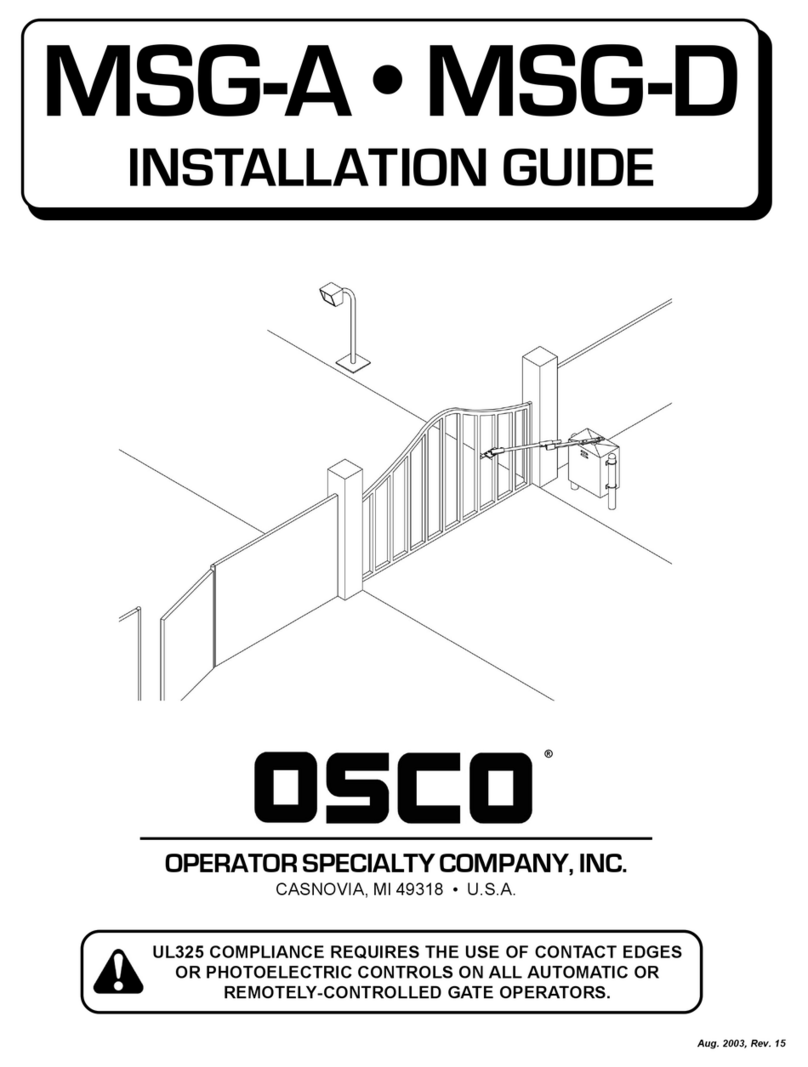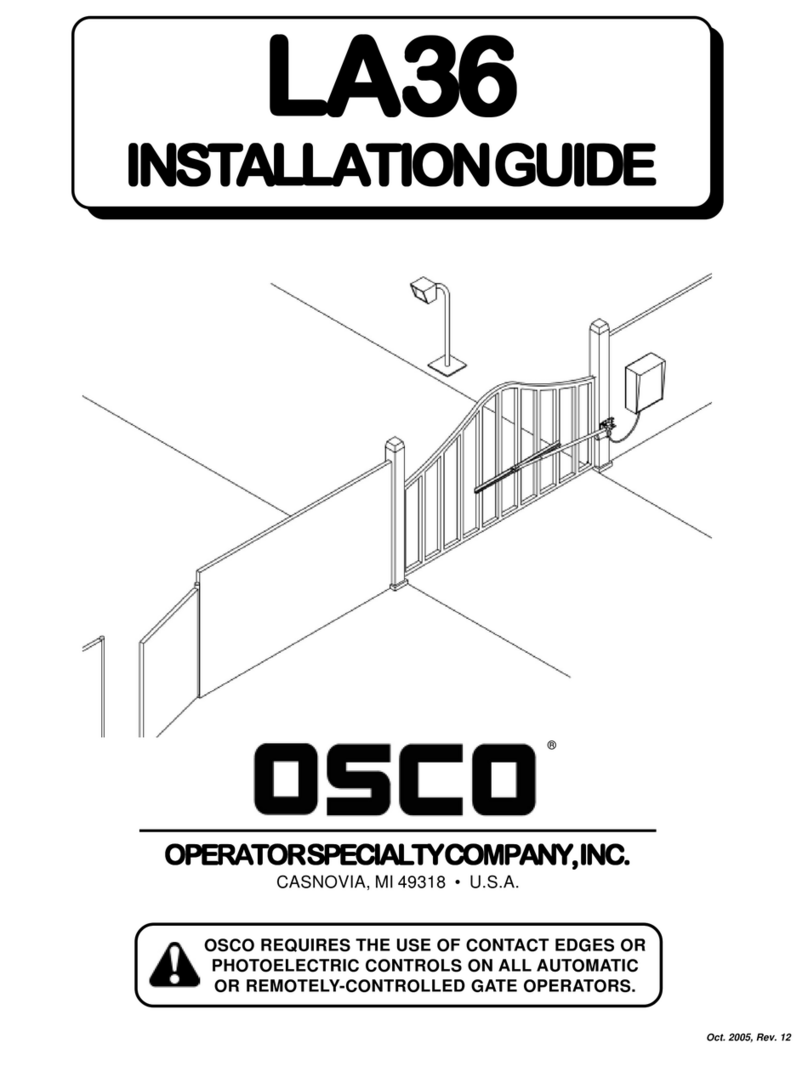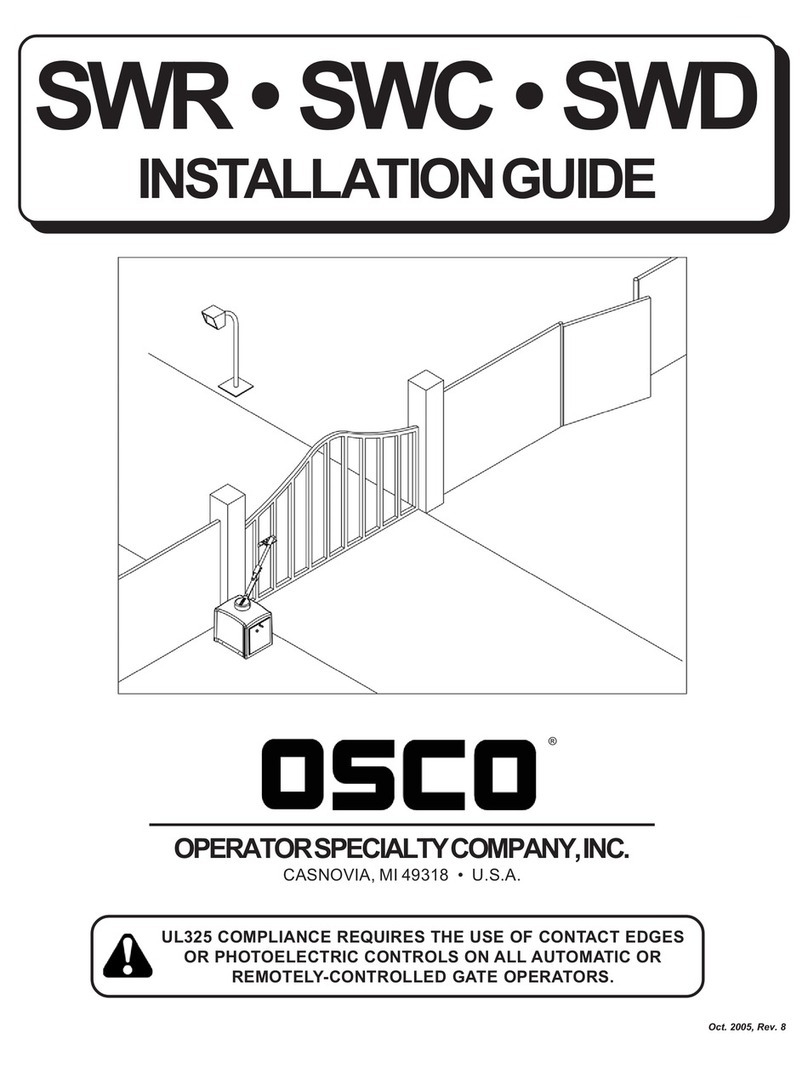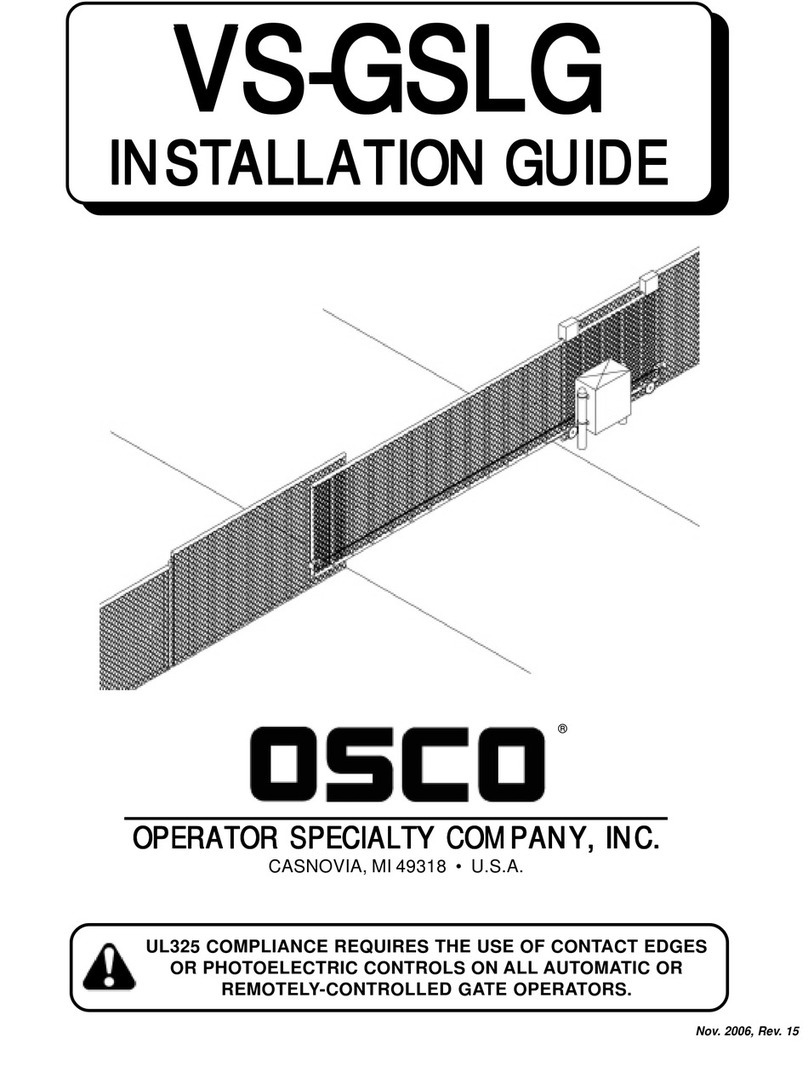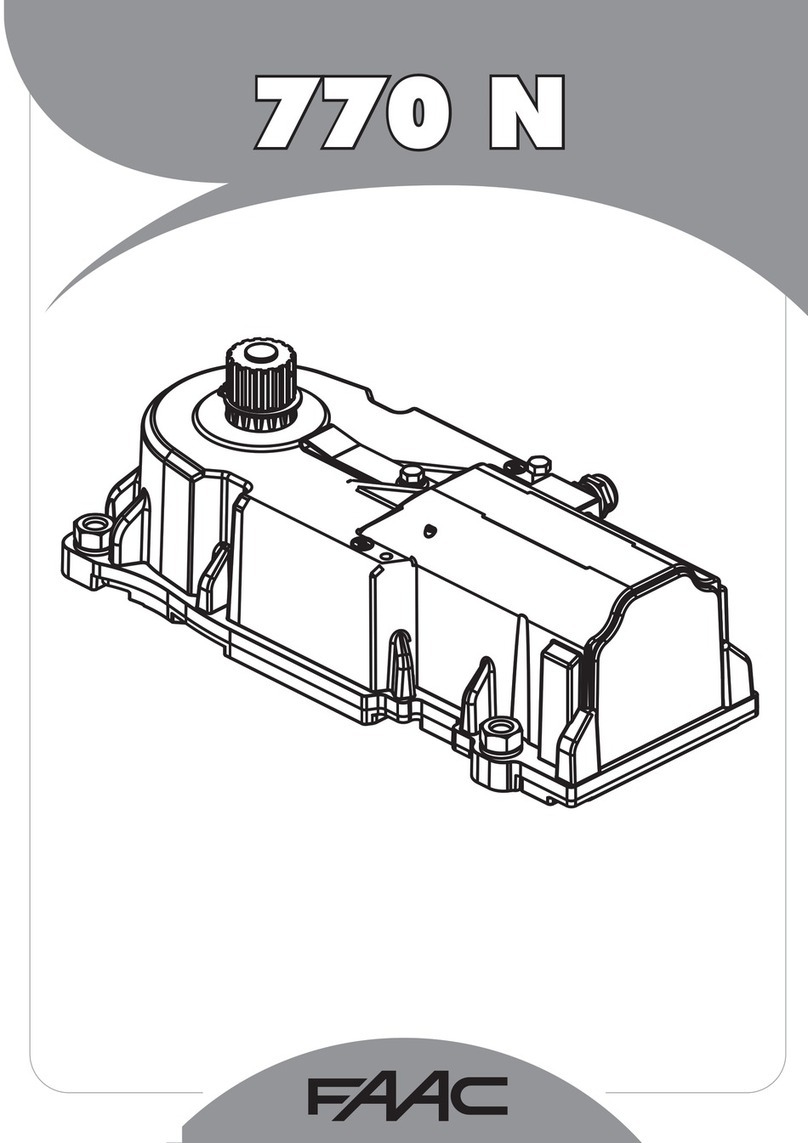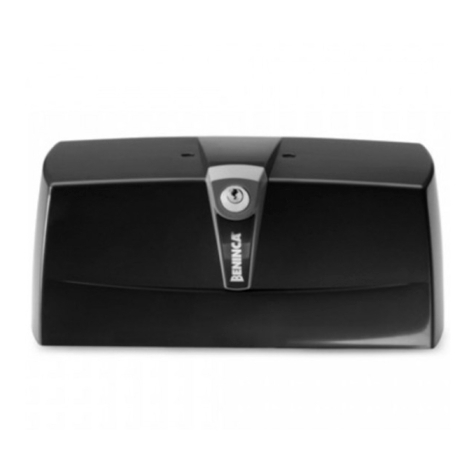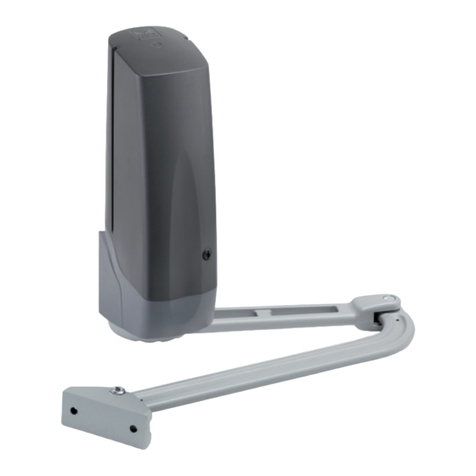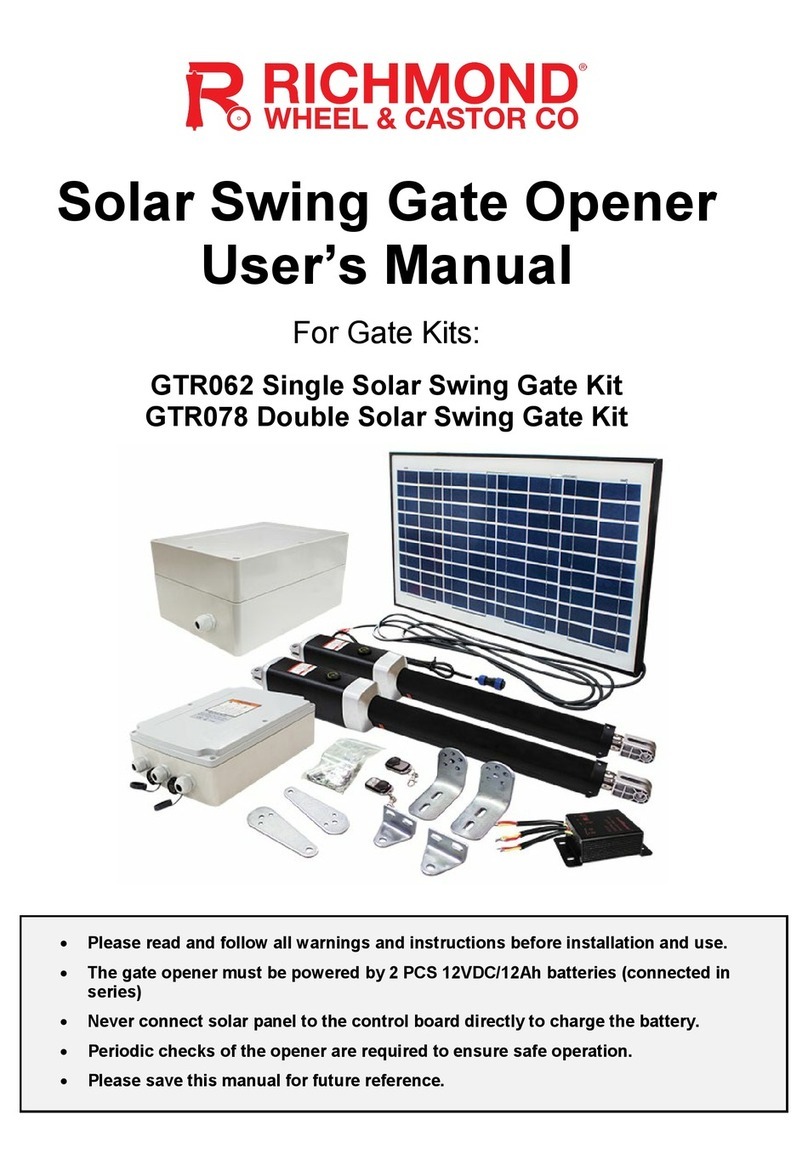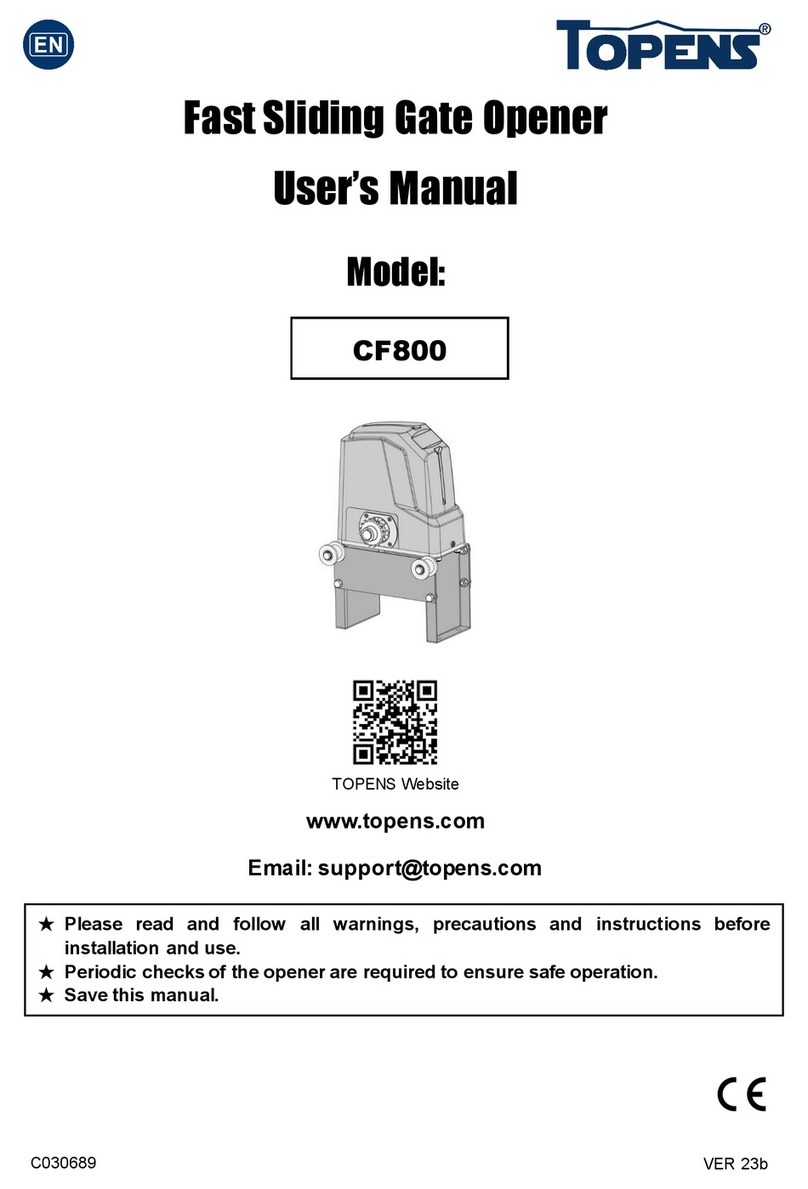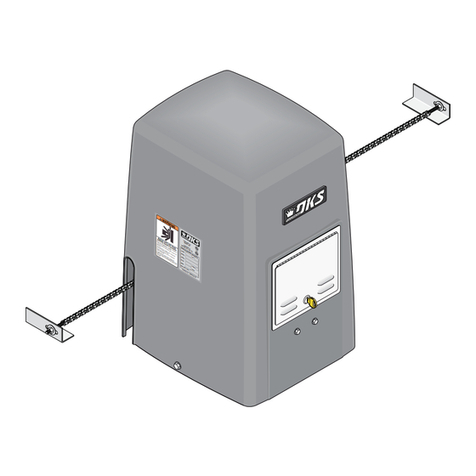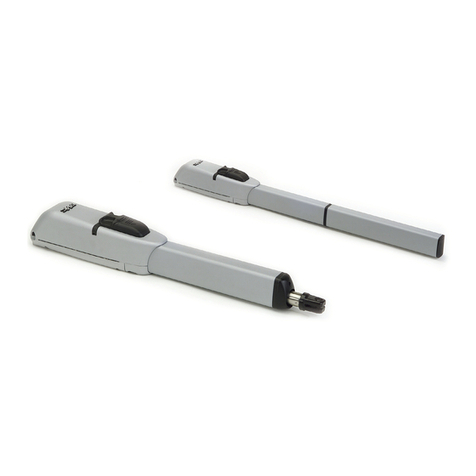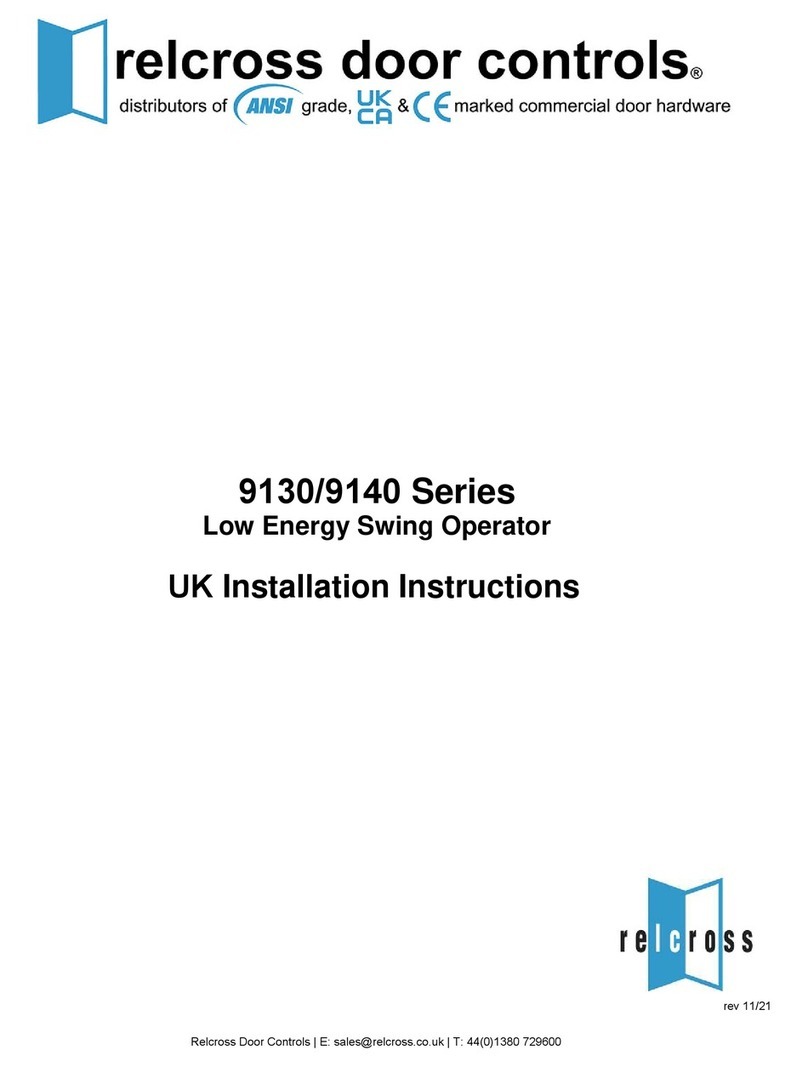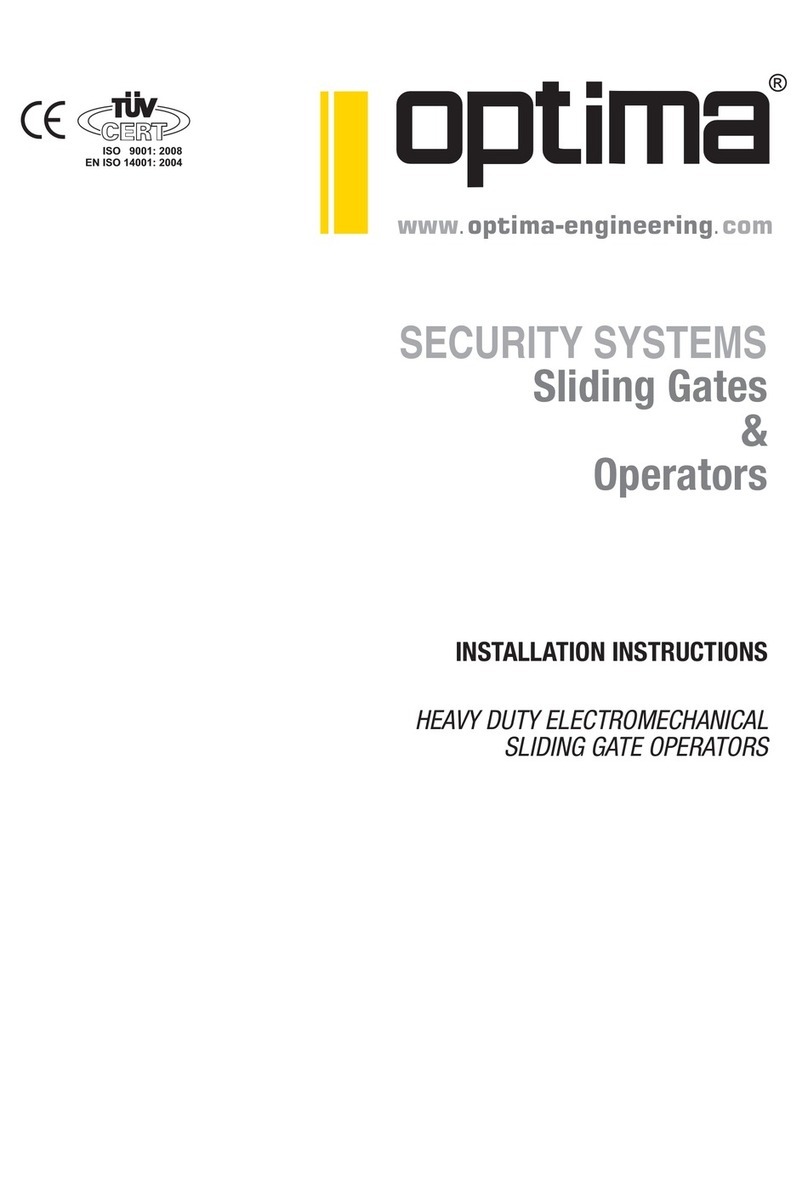OSCO GSLG-A User manual

GSLG-A
INSTALLATION GUIDE
June 2003, Rev. 11
UL325 COMPLIANCE REQUIRES THE USE OF CONTACT EDGES
OR PHOTOELECTRIC CONTROLS ON ALL AUTOMATIC OR
REMOTELY-CONTROLLED GATE OPERATORS.
OPERATORSPECIALTYCOMPANY,INC.
CASNOVIA, MI 49318 • U.S.A.
®

GSLG-A OPERATOR INSTALLATION GUIDE
- 2 -
TABLEOFCONTENTS
PRE-INSTALLATIONINFORMATION
GateOperatorClassifications ......................................................................................................................................3
SafetyInformation and Warnings .................................................................................................................................3
Pre-InstallationInformation ...........................................................................................................................................3
Warranty......................................................................................................................................................................3
INSTALLATION
WiringSpecifications ...................................................................................................................................................4
PostMounting Instructions ..........................................................................................................................................5
Gate Bracket and Chain Assembly Instructions ...........................................................................................................6
Vent PlugInstallation ...................................................................................................................................................7
TorqueLimiterAdjustments..........................................................................................................................................7
ElectricalConnection and Adjustments........................................................................................................................8
Limit Nut Adjustments .................................................................................................................................................8
CONTROLBOARD ADJUSTMENTSand ACCESSORYCONNECTIONS
ControlBoardAdjustments ..........................................................................................................................................9
TerminalConnection Descriptions ..............................................................................................................................10
CurrentSensingAdjustments ....................................................................................................................................11
CloseDirectionCurrentSense Adjustment ................................................................................................................ 11
OpenDirectionCurrentSenseAdjustment.................................................................................................................11
Maximum RunTimer Adjustment ............................................................................................................................... 11
AutoCloseTimer Adjustment .................................................................................................................................... 11
Master/SlaveConnection ........................................................................................................................................... 11
OnboardL.E.D.IndicatorDescriptions .......................................................................................................................12
ImportantNotesforInstallationofMaster/SlaveApplications......................................................................................13
ControlandAccessory Connection Illustrations ....................................................................................................14-17
ILLUSTRATIONS
LoopLayoutIllustration ..............................................................................................................................................18
EdgeLayoutIllustration#1.........................................................................................................................................19
EdgeLayoutIllustration#2.........................................................................................................................................20
PhotoEye Illustration.................................................................................................................................................21
Picket Gate Illustration ..............................................................................................................................................22
TrackGateIllustration................................................................................................................................................23
TROUBLESHOOTING ...................................................................................................................................................24
PARTS LISTS
HowtoOrderReplacementParts...............................................................................................................................24
ModelGSLG-A Mechanical Parts Exploded View ......................................................................................................25
Model GSLG-A Mechanical Parts List .......................................................................................................................26
Model GSLG-A Single Phase Control Box Exploded View and Parts List ..................................................................27
Model GSLG-A Three Phase Control Box Exploded View and Parts List ...................................................................28
PREVENTATIVEMAINTENANCE ..................................................................................................................................30
GATE OPERATORINSTALLATION CHECKLIST ..........................................................................................................32
CAUTION!
DO NOT INSTALL
CONTROLSON A
GATE ORFENCE LINE
CAUTION!
ONLY QUALIFIEDSERVICE
TECHNICIANSSHOULD
WORK ON AN OSCO
SLIDEGATEOPERATOR
CAUTION!
DO NOT INSTALL
CONTROLS
ONTHE OPERATOR

GSLG-A OPERATOR INSTALLATION GUIDE
- 3 -
Read the following before beginning to install OSCO slide
gate operators:
1. Readtheyellow “Safety Instructions” brochure enclosed
with the packet of information. If you do not have one,
pleasecallOSCOat1-800-333-1717torequestone. Read
andfollow all instructions.
2. All electrical connections to the power supply must be
made by a licensed electrician and must observe all
national and local electrical codes.
3. A separate power-disconnect switch should be located
neartheoperatorsothatprimarypowercanbeturnedoff
whennecessary.
4. Install the enclosed warning signs on both sides of the
gate. Each sign must be plainly visible from the side of
the gate on which they are mounted.
5. Never reach between, through or around the fence to
operatethegate.
6. You must install all required safety equipment.
GATEOPERATOR
CLASSIFICATIONS
PRE-INSTALLATIONINFORMATION
Before unpacking, inspect the carton for exterior damage. If
youfinddamage,advisethedeliverycarrierofapotentialclaim.
Inspect your package carefully. You can check your acces-
sory box parts with the enclosed packing slip for your conve-
nience.Claimsforshortages will be honored for only 30 days
fromthe date of shipment.
Before installing the operator, read this manual completely
toensureall requirements for proper installationarepresent.
Verify that the voltage to be used matches the voltage of the
operator.
SAFETYINFORMATION
ANDWARNINGS
IMPORTANT!!
Beforeinstallingthegateoperator,makesurethegate’sslide
isfreeandlevelthroughouttheentireopeningdistance.If the
gate does not seem to operate properly, it may affect the op-
erator performance or greatly shorten the life of the unit. The
gate should be designed so that airflow through the fabric is
ampletopreventwindresistance and drag.
All gate operators can be divided into one of four different
classifications,dependingon their design and usage.
Class I: Residential
A vehicle gate operator (or system) intended for use in a
home of one to four single-family dwellings, or a garage or
parkingareaassociatedtherewith.
Class II: Commercial or General Public Access
A vehicular gate operator (or system) intended for use in a
commerciallocation or buildingsuchasa multi-family hous-
ingunit (five or more single-familyunits), hotel, garage, re-
tailstore,or other building servicing thegeneralpublic.
Class III: Industrial or Limited Access
Avehicular gate operator (or system) intended for use in an
industrial location or building such as a factory or loading
dockarea orotherlocationsnot intended toservicethe gen-
eralpublic.
ClassIV: Restricted Access
A vehicular gate operator (or system) intended for use in a
guarded industrial location or building such as an airport
security area or other restricted access locations not ser-
vicing the general public, in which unauthorized access is
preventedvia supervision by securitypersonnel.
The following contact or non-contact obstruction
detection devices have been approved for use with
OSCO slide gate operators as part of a UL325 com-
pliant installation:
2510-264 EMX Model IRB-325 photo eye 60’ with
mountinghardware
2520-031 MMTC Model E3K photo eye, 28’ with
mountinghardware
2520-178 5’ Miller Edge MG020 with transmitter
2520-134 5’ Miller Edge MG020 with coil cord
2510-163 4’ Miller Edge MG020 with coil cord
2520-246 5’ Miller Edge MGR20 with coil cord
2520-271 5’ Miller Edge MGS20 with coil cord
LIMITED TWO-YEAR WARRANTY
Thiselectric operator is warranted fora period of two (2)
years from date of sale against defects in materials or
workmanship. Defective part(s) shall be repaired or re-
placed at no charge, at the manufacturer’s option. All
accessoriesarecoveredbytheirmanufacturer’swarranty.
The manufacturer will not be responsible for trans-
portation and/or field service charges.
The above warranty is in lieu of all other warranties, ex-
pressedor implied, and shall be considered void ifvisible
evidence implies recommended installation procedures
andmaintenanceinstructionswerenotfollowed,or if the
electricoperator was not sized appropriatelyforthe par-
ticular installation.

GSLG-A OPERATOR INSTALLATION GUIDE
- 4 -
USE COPPER WIRE ONLY! ACCESSORY WIRING
All Models
24VDC
*Over 350 ft. use DC power.
0-2000
14
24VAC
250
350*
14
12
Volts
Maximum
Distance (ft.)
Wire
Gauge
1. Select from the chart at the bottom of this page corresponding to the
model, voltage and horsepower rating of your operator.
2. The distance shown on the chart is measured in feet from the opera-
tor to the power source. DO NOT EXCEED THE MAXIMUM DIS-
TANCE. These calculations have been based on standard 115V and
230V supplies with a 10% drop allowable. If your supply is under the
standard rating, the runs listed may be longer than what your appli-
cation will handle, and you should not run wire too near the upper
end of the chart for the gauge of wire you are using.
3. When large-gauge wire is used, a separate junction box (not sup-
plied) may be needed for the operator power connection.
4. All control devices are now 24VDC, which can be run considerable
distances. 24VAC is available for other devices, such as loop detec-
tors and photo eyes.
5. Wire run calculations are based on the National Electrical Code, Ar-
ticle 430 and have been carefully determined based on motor inrush,
brake solenoids, and operator requirements.
WIRINGSPECIFICATIONS
6. Connect power in accordance with local codes. The green ground
wire must be properly connected.
7. Wire insulation must be suitable to the application.
8. Control wiring must be run in a separate conduit from power wiring.
Running them together may cause interference and faulty signals in
some accessories.
9. Electrical outlets are supplied in all 115VAC models for convenience
with occasional use or low power consumption devices only. If you
choose to run dedicated equipment from these devices, it will de-
crease the distance for maximum run and the charts will no longer be
accurate.
10. A three-wire shielded conductor cable is required to connect master
andslave operators. Youmust use Belden8760 Twisted PairShielded
Cable (or equivalent) only – OSCO part number 2500-1982, per
foot). See page 9for details of this connection, as well as dip switch
selection. Note: The SHIELD wire should be connected in both
the master and slave operators
esahP3:gniriWrewoP
stloV PH& ecnatsiDxaM lauDelgniS eriW eguaG stloV PH& ecnatsiDxaM lauDelgniS eriW eguaG stloV PH& ecnatsiDxaM lauDelgniS eriW eguaG
V8022/1 PH
2411 6181 0982
175 809 5441
2101
8
V0322/1 PH
4431 7312 0043
276 9601 0071
2101
8
V0642/1PH
1483 6016 2179
1291 3503 6584
2101
8
V802 4/3PH
029 4641 0332
064 237 5611
2101
8
V032 4/3PH
4801 3271 1472
245 268 1731
2101
8
V0644/3PH
9723 2125 1928
0461 6062 6414
2101
8
V802
PH1
417 6311 4081
753 865 209
2101
8
V032
PH1
048 6331 4212
024 866 2601
2101
8
V064
PH1
9862 4724 8976
5431 7342 9933
2101
8
MODEL GSLG-A – THREE PHASE
MODEL GSLG-A – SINGLE PHASE
gniriWrewoP
stloV PH& ecnatsiDxaM lauDelgniS eriW eguaG stloV PH& ecnatsiDxaM lauDelgniS eriW eguaG stloV PH& ecnatsiDxaM lauDelgniS eriW eguaG
V511
2/1PH
222 453 665 009 0341
111 771 382 054 517
2101
8
6
4
V802
2/1PH
067 0021 4291 0603 4684
083 006 269 0381 2342
2101
8
6
4
V032
2/1PH
498 2241 4622 0063 4275
744 117 2311 0081 2682
2101
8
6
4
V511
4/3PH
871 282 054 617 0411
98 141 522 853 075
2101
8
6
4
802
4/3PH
406 859 6251 4242 6583
203 874 367 2121 8291
2101
8
6
4
V032
4/3PH
017 8211 6971 2582 8354
553 465 898 6241 9622
2101
8
6
4
V511
PH1
061 452 604 646 6201
08 721 302 323 315
2101
8
6
4
V802
PH1
445 468 4731 4812 6743
272 234 686 2901 8371
2101
8
6
4
V032
PH1
046 6101 6161 0752 0904
023 805 808 5821 5402
2101
8
6
4
12-02-8

GSLG-A OPERATOR INSTALLATION GUIDE
- 5 -
POST MOUNTING INSTRUCTIONS FOR MODEL GSLG-A
SIDEPLATEINSTALLATION
Before installing, make sure the gate rolls or slides freely,
and that all exposed rollers are properly covered. The gate
must be covered with fabric with openings no larger than
2 1/4” in size, to a minimum height of 48 inches from ground
level. On picket-style gates, if pickets are spaced less than
2 1/4” apart, mesh is optional.
Use two 3 - 3 1/2” OD galvanized posts and secure with
concrete footings as shown, length to be determined by
local codes, frost line depth and soil conditions. Secure the
operator to the posts using the 4” U-bolts, side plates, and
hardware. There are a total of eight side plates. There are
six 3/16” side plates which should be mounted on the
outside top and bottom of the cabinet, two 3/16” side plates
which go on the top inside and two 1/2” side plates which
should be mounted on the inside top of the cabinet as shown
in the illustration at the right.
To assemble the drive chain and gate brackets, refer to page
6. Make sure that the chain sag does not exceed recom-
mended sizes and that the chain does not come into contact
with the moving parts of the gate or ground.
For optional pad mounting instructions, see OSCO drawing
#2700-360.
ASEPARATE PEDESTRIAN GATE IS REQUIRED FOR ALL
PEDESTRIAN TRAFFIC. THIS GATE MUST BE A MINIMUM
DISTANCE OF 7 FEET FROMTHE VEHICULAR
GATE ANDGATE OPERATOR
08-01-3

GSLG-A OPERATOR INSTALLATION GUIDE
- 6 -
Assemble a gate bracket (1) to the front edge of the gate,
using two U-bolts (2), and mounting hardware (3). Before
tightening down completely, be sure the bracket is parallel
tothegate.Tighten the U-bolt hardware the rest of the way,
thenscrew thesquarehead bolts(4)intothe threadedholes
in the gate plate until they bottom out against the gate.
These will help keep the bracket from twisting on the pipe.
Slideathreadedchainpin (5)throughthe bracketasshown,
with spring (6), flat washer (10), and two hex nuts (7).
Attach one end of the drive chain (8) to the chain pin using
masterlink(9) and begin unrolling ittowardthe operator.
Removetheraincover fromtheback oftheslidegateopera-
tor.Carefully thread the drivechainunderthefirstidler,over
thedrivesprocket, and then under thelastidler. Makesure
youfeed most of the chain through thesprocketsforattach-
ing to the back end of the gate.
Assemble the other gate bracket on the rear edge of the
gate,usingthe same process as you didwith thefrontgate
bracket. Once this is done, take the other chain pin, spring
andjamnuts and assemble with theendof drive chain and
the other master link.
At this point you should be able to adjust the chain tension
bytighteningthejamnuts on each end. Approximately 1/4”
to 3/8” of slack per foot of drive chain is acceptable. Make
surethe chain does notdragontheground,across the gate
rollersortheidler frame of the operator.
Additional mounting holes have been provided in the gate
bracketfor installer convenience.
GATEBRACKETANDCHAINASSEMBLYINSTRUCTIONS
Numbered items in these
drawingsareforinstructional
referenceonly.Foractualpart
numbers,gotothe parts lists
in the back of this booklet.

GSLG-A OPERATOR INSTALLATION GUIDE
- 7 -
VENTPLUGINSTALLATION
Gearreducersusedin OSCO gate operators will have solidplugs installedpriortoshipmentin order to keep the oil insidefrom
spilling out during shipping. A vent plug has been provided to replace this plug during installation. This plug will look similar to
theonesshown below. Some modelsmayhave a vent plug with abreatherpin. This pin should beremovedafter installing the
operator.
OR
TORQUELIMITERADJUSTMENTS
Before adjusting the torque limiter, make sure the gate is in good
working condition. One person should be able to move the gate by
hand. Becertain the gatemovesfreelyand without binding through-
outits travel. Torquelimiters are set lightatthe factory and mustbe
adjustedduringinstallation.Adjustthetorquelimitertightenoughto
keepitfromslipping during normal operation.
To adjust the torque limiter in model GSLG-A
1. Loosen the setscrew in the adjustment nut.
2. To increase the output, turn the adustment nut clockwise one
flat, or 1/6 turn, at a time until desired output is obtained.
Toreducetheoutput,turntheadjustmentnut counterclockwise
one flat, or 1/6 turn, at a time until desired output is obtained.
3. Retighten the setscrew in the adjustment nut.
MODELGSLG-A
SETSCREW
ADJUSTMENT NUT

GSLG-A OPERATOR INSTALLATION GUIDE
- 8 -
ELECTRICALCONNECTIONANDADJUSTMENTS
All OSCO gate operators are supplied with a power disconnect switch to turn on and off the power supply available to the
operator. Incoming power should be brought into the operator and connected to the labeled pigtails in the disconnect box
following wiringspecifications on page 4.A wiring connections print canbefound on the inside coverofthe operator.
Properthermalprotectionissupplied withtheoperator.The motorcontainsa thermaloverloadprotectortoprotectfromoverheat-
ingthemotordue to overload or high-frequency operation. Thisoverloadwillautomaticallyreset after the motor cools down.
LIMITNUTADJUSTMENTS
Thelimit nuts are notpresetat the factory andmustbe adjusted for thelength of the gate theoperator is installed on.Thelimit
switches are activated by two threaded nylon rotary limit nuts which are attached to a threaded shaft and driven by chain and
sprocketsfrom the main drive shaft.Remove the cardboard filler beforeattempting to adjust the limitnuts.
With the gate connectedto the gate operatorin a mid-travel position, andthe power disconnect switchturned OFF, disconnect
theoperator by usingthemanualdisconnectlever. Instructions forthemanualdisconnectcan be foundintheindividualoperator
owner’s guides. Once the operator has been disconnected, manually move the gate by hand to within a foot of its fully open
position (the foot of distance is necessary to allow for coasting of the operator after the limit switch is tripped).
Once the gate is in this position, adjust the open limit nut until it activates the limit switch for open, LSO-1. Press down on the
detentplate and rotate thenutalong the threaded shaft.Refer to the illustrationbelowfor additional details.
Once the open limit nut is set, repeat the above process for the close direction nut and the LSC-1 limit switch.
Afterfinishingthe initial limit nut adjustments, reposition thegatetoapproximately its center of travel. Re-engage theoperator
andturn thepowerdisconnectON. Standclearofany moving partsandpressthe OPEN buttononthethree-button station.Ifthe
gate begins to close instead of open, press the STOP button immediately. Find the dip switch block on the main control board
and switch thehand of operation (dipswitch #4, seepage 9)andtrytoopenthegateagain.Observethegate as it runs through
acompletecycleinbothdirections,andadjust your limits again if necessary.Finelevelsofadjustmentcanalsobeachieved by
adjusting a few teeth on the nut at a time. If the gate stops in midtravel, the open or close current sensor adjustment or the
maximumrun timer may needadjustment (see page 11).
Power supply must be of correct voltage and phase.
Always disconnect power from operator before servicing.
Keep clear of gate during operation.
POWER DISCONNECT BOX
(115VAC VERSION SHOWN)
L1
(WHITE)
L2
(BLACK)
GROUND
(GREEN)
9-26-02
ONA RIGHT-HAND OPERATOR:
OPEN LIMIT SWITCH IS THE ONE CLOSER
TO THE FRONT OF THE OPERATOR. ON A
LEFT-HAND OPERATOR, THE OPEN LIMIT
SWITCH IS THE ONE FURTHEST AWAY
FROMTHE FRONT OF THE OPERATOR.

GSLG-A OPERATOR INSTALLATION GUIDE
- 9 -
CONTROLBOARDADJUSTMENTS
NOTE:DONOTFORCE270-DEGREEPOTENTIOMETERS
BEYONDTHEIRNORMALRANGEOFMOTION
ORDAMAGEMAYRESULT!
Control Board
with AC
Motor Board
DIAGNOSTIC
L.E.D.s
TERMINAL STRIP #2
CONNECTOR
TERMINAL STRIP #1
CONNECTOR
LIMIT SWITCH
CONNECTOR
LIMIT SWITCH
L.E.D.s
3A Fuse
2A Fuse
Auto Close Timer Adjustment: This 270-degree adjustable potentiometer will signal the operator to close automatically,
providedno open, reversing orobstructionsignalsarepresent from the fully-openposition.Thistimeris adjustable from 0to 124
seconds. This feature is turned on or off using dip switch #1.
Maximum Run Timer Adjustment: This270-degree adjustable potentiometer willsignal the operatorto stop running onceit
counts down, unless a limit switch is reached or an input is received first. Each time the motor starts, this timer will begin
counting. This timer is adjustable from 15 to 100 seconds. If the timer expires, the unit locks out and the emergency alarm
sounds.
Open Direction Current Sense Adjustment: This multiturn potentiometer is used to calibrate the built-in current sensing
featurefordetection of obstructions while running intheopendirection.
Close Direction Current Sense Adjustment: This multiturn potentiometer is used to calibrate the built in current sensing
featurefordetection of obstructions while runninginthe closed direction.
Master/Slave Connection Block: Thisterminalblock is used in conjunction with two operators toconfigure twogates toopen
andclosetogether.
Dip Switches:
#1 This switch turns the auto close timer off/on.
#2 This switch is used in conjunction with alarms and flashing lights that may be added to the operator. When the switch is
inthe ON position, these devices willstartapproximately two seconds prior totheoperator starting. In the OFF position,
thedevices will only work whilethe operator is running.
#3 This switch is used in conjunction with single-button controls and radio receivers. In the ON position, successive inputs
will cause signals in the order of OPEN-STOP-CLOSE-STOP. In the OFF position, inputs will cause an OPEN signal
unless the gate is fully open, in which case it will signal CLOSE.
#4 Thisswitchdetermines right-handvs.left-handbehavior. When lookingfrominside the protectedareatoward the gate,the
sideof the drive the operator is on determines its hand ofoperation.IntheOFF position,theoperatorissetfor right-hand.
#5 When turned ON, this switch will allow a one-second delay for solenoid locks to unlock before the motor starts.
#6 IntheON position, this switch willdisable the inherentDC brake in DC operators only.Inaddition,theR2brakeresistor
on the DC motor board must be cut from the board (refer to the picture above). In the OFF position, the DC brake will
function.
#7 Not used at this time.
#8 This switchis used toset Master/Slave configuration. Operatorswhich are stand-alone ormaster units should beset to
OFF, while only slave units should have this switch set to ON.

GSLG-A OPERATOR INSTALLATION GUIDE
- 10 -
You must follow all required safety precautions and instructions at all times. Review the safety brochure
included with the operator. If any pages are missing or unreadable, contact OSCO at 1-800-333-1717 to request
additional copies.
Never connect a button station within reach of the gate or on the side of the gate operator.
Do not adjust the circuit board current sensing feature too high. It should be adjusted high enough to keep the
gate from falsely triggering the sensing, but no higher than necessary for the gate to operate. Do not defeat the
purpose of this function!
TERMINALCONNECTIONDESCRIPTIONS
TERMINALS FUNCTION DESCRIPTIONOF FUNCTION
24VAC 24VAC Provides24Volt AC power for accessories.
24VAC N Note: DC models will NOT have 24Volt AC power available.
24VDC+ 24VDC Provides24VoltDCpower for accessories.
24VDC-COMM.
1 & 4 OPEN Openstheoperator. Several accessories suchasbuttonstations, keypads, trans-
mitters and card readers can be wired to open.
3 & 4 CLOSE Closestheoperator. Use caution when wiring accessoriestotheseterminals. The
gate must be clearly visible from the location of any accessories wired to
close.
4 & 5 SINGLE-BUTTON Performs the single-button function whichwillalternatebetweenopenandcloseor
open, stop and close - depending on dip switch #3. (See page 9for details.)
2 & 4 STOP Stops the operator. If no stop button is used, a jumper is required across 2&4.
4 & 6 REVERSE Thisfunction will cause a reversal when thegate is traveling closedand will travel
backtothe fully open position.Loopdetectors are often wired forreverse.
4 & 50 OPEN This function works only while the operator is opening. Any signal to this function
will cause the gate to stop, reverse a short distance, and then stop again. At this
time the auto close timer is disabled, and a renewed input will be required to start
the gate again. Should the gate be restarted and the signal occur again prior to
reaching a limit, the gate will stop again, and this time will sound the emergency
alarm and lock out.
4 & 51 CLOSE Thisfunction works exactly like theOPENOBSTRUCTION,except that it will only
work in the closing direction.
4 & 11 SHADOW/HOLD Thisfunctionwill keep the gate initsfully open position while thesignalispresent.
Thisistypicallyusedwithaloopandloopdetectortokeepalargeswing gate open
whilevehiculartrafficispassingthrough.
24VDC+& 60 RUN/PRE-START A 24VoltDC device such as a strobe light oralarm can be wired to theseterminals.
Dependingon dip switch #2, thesedeviceswilleitherbegintwo seconds before the
operator starts, or only while the motor is running. (See page 9for details.)
OBSTRUCTION
OBSTRUCTION

GSLG-A OPERATOR INSTALLATION GUIDE
- 11 -
CURRENTSENSINGADJUSTMENTS
Because gates vary in construction and may have different force requirements in the open and close directions to move, the
OSCO control board has separate Multi-turn potentiometers for adjusting in both directions independently. The adjustment
shouldbesetlightenoughto maintain minimal force (50-75 lbs.) should an obstruction occur,buthighenough to keep the gate
movingunder normal conditions without interruption.
Priortoadjustingtheoperatorcurrentsensingfunctions, make sure the gate moves freely in both directions. A badlyaligned or
poorlymaintainedgatemaycause false triggering of the current sensor.Referto page 9when following the instructions below.
Afactory adjustment tool hasbeensupplied to make theseadjustmentseasier. This tool hasbeen taped to thecontrolbox for
yourconvenience. CLOSEDIRECTIONCURRENTSENSEADJUSTMENT
When the gate operator leaves the factory, it has been preset for a relatively light gate function and will require additional
adjustment.Begin by startingthe gate going closed.If the operatorstops and reverses, turn the close directionpotentiometer
(see page 9) one turn higher, press the STOP button, and try again. Repeat this process until the gate no longer causes false
trippingofthecurrentsensor. Note that each time the gate operator reverses, the STOP buttonmustbepressed.Next,turnthe
close direction potentiometer lower slowly while the operator is running the gate closed until the gate operator stops and
reverses again. From this point, turn the close direction potentiometer higher by 1 1/2 turns for all 115 Volt AC and 24 Volt DC
operators, and by 3/4 of a turn higher for all 230 Volt AC operators.
OPENDIRECTIONCURRENTSENSEADJUSTMENT
Repeatthesameprocesswiththeopen direction potentiometer while running the gate in the opendirection. Once thisis done,
run the gate through several complete cycles and make sure the gate does not false trip in either direction.
MAXIMUMRUNTIMERADJUSTMENT
Thisadjustablepotentiometersetsthemaximumlength of time the motor will run before shutting down. Itshould be configured
for the time it takes to run the gate fully open or closed, plus an additional 15 seconds. See page 9for details.
AUTOCLOSETIMERADJUSTMENT
Thisadjustable potentiometer sets the lengthoftimewhichelapsesbefore the gate operator automaticallyclosesthegate,from
thefully openposition,provided noopen,reversing,or obstructionsignalsarepresent. Thisfeaturecan beturnedonor offviadip
switch selection. See page 9for details. Do not use the auto close timer without an appropriate reversing device
installed!
MASTER/SLAVECONNECTION
A three-wire shielded conductor cable is required to connect master and slave operators. You must use Belden 8760 Twisted
PairShielded Cable (orequivalent)only– OSCO partnumber2500-1982,perfoot). See page9fordetailsof this connection,as
well as dip switch selection. Note: The SHIELD wire should be connected in both the master and slave operators. In addition, you
must run power to both the master and slave operators.
Multi-turn Potentiometer
Remember it is important not to set the adjustment
too high! Doing so will defeat the purpose of the cur-
rent sensing as an obstruction detecting feature.

GSLG-A OPERATOR INSTALLATION GUIDE
- 12 -
ONBOARDL.E.D.INDICATORDESCRIPTIONS
Control Board L.E.D. Indicators:
OPEN This indicator is lit when an open signal is present. This signal can come from such devices as button
stations, radio receivers, keypads and telephone entry systems.
CLOSE This indicator is lit when a closed signal is present. This signal typically comes from three-button stations.
STOP This indicator is lit when there is a break in the stop circuit. Make sure there is a stop button wired in and
workingproperly.
SINGLE This indicator is lit when a signal from a single-button station or radio receiver is present.
CLOSEOBST This indicator is lit when aclose obstruction signalispresent.Thissignal can come from edges and photo
eyes which have been wired to the close obstruction inputs.
OPENOBST This indicator is lit when an open obstruction signal is present. This signal can come from edges and
photoeyes which have been wiredtothe open obstruction inputs.
SAFETYLOOP This indicator is lit when a reversing signal is present. This signal is generated by a loop detector wired to
the safety loop terminals.
SHADOWLOOP This indicatoris lit whena shadow/hold open signalis present. Thissignal is generated bya loop detector
wiredto the shadow loop terminals.
Thisindicator is lit when the open #1 limit switch is activated on a right-handoperator, or the close #1 switch
on a left-hand. If this indicator is lit and the gate is not in its full open/closed position, the limit may need
adjusting or the limit switch may need replacing.
Thisindicator is lit when the open #2 limit switch is activated on a right-handoperator, or the close #2 switch
ona left-hand.
Thisindicator is litwhen the close#1 limit switch is activated on a right-hand operator, or the open #1 on a
left-hand. If this indicator is lit and the gate is not in its full open/closed position, the limit may need
adjusting or the limit switch may need replacing.
Thisindicator is lit when the close #2 limit switch is activated on a right-handoperator, or the open #2 switch
ona left-hand.
Motor Board L.E.D. Indicators:
NONLABELED Oneofthese two indicators will belitwhen the motor is runningthegate open, and the otherislit when the
motor is running the gate closed.
BRAKEREL. This indicator is lit when the brake is NOT applied.
LSO-1
LSO-2
LSC-1
LSC-2
LSC-1
LSC-2
LSO-1
LSO-2
LH RH

GSLG-A OPERATOR INSTALLATION GUIDE
- 13 - 12-01-5
IMPORTANTNOTESFOR
INSTALLATIONOFMASTER/SLAVEAPPLICATIONS
When setting up Master/Slave gate operators, it is best to make adjustments and run each operator individually. To do this,
simply:
a. SetDipSwitch#4toproperhand of operation (right-hand or left-hand)
b. Set Dip Switch #8 as Master (off)
Runeachoperator making current sensing adjustments asnecessary, as indicated ontheControlBoard Adjustments page of
this installation guide. When both operators have been adjusted, turn power off, then turn on Dip Switch #8 in the operator
chosenas the Slave.
Thetimer to close and radio/singlebuttonbehavior are set in theMaster operator.
Thefollowingselectionsaresetindividually:
CurrentSensing
MaximumRun Timer
One-SecondLock Release
Three-SecondPre-Start Warning
Right/Left-HandSelections

GSLG-A OPERATOR INSTALLATION GUIDE
- 14 -
CONTROLandACCESSORYCONNECTIONILLUSTRATIONS

GSLG-A OPERATOR INSTALLATION GUIDE
- 15 -
CONTROLandACCESSORYCONNECTIONILLUSTRATIONS

GSLG-A OPERATOR INSTALLATION GUIDE
- 16 -
CONTROLandACCESSORYCONNECTIONILLUSTRATIONS

GSLG-A OPERATOR INSTALLATION GUIDE
- 17 -
CONTROLandACCESSORYCONNECTIONILLUSTRATIONS

GSLG-A OPERATOR INSTALLATION GUIDE
- 18 -
LOOPLAYOUTILLUSTRATION
Referto Connection Descriptions on page10and Loop Accessory Connections onpage 17 for details.
2-03-10

GSLG-A OPERATOR INSTALLATION GUIDE
- 19 -
EDGELAYOUTILLUSTRATION#1
RefertoConnection Descriptions on page 10andContact Edge Connections on page16for details.

GSLG-A OPERATOR INSTALLATION GUIDE
- 20 -
EDGELAYOUTILLUSTRATION#2
RefertoConnection Descriptions on page 10andContact Edge Connections on page16for details.
Table of contents
Other OSCO Gate Opener manuals
Popular Gate Opener manuals by other brands
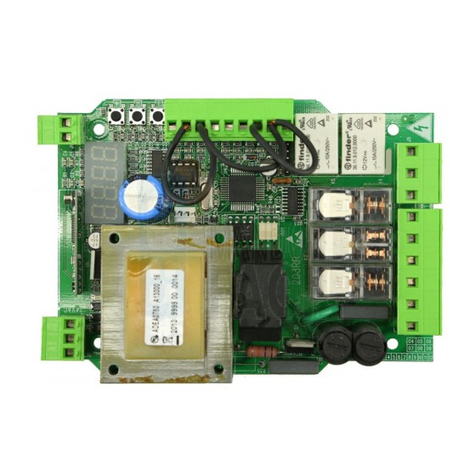
Dea
Dea 203RR Instructions and warnings
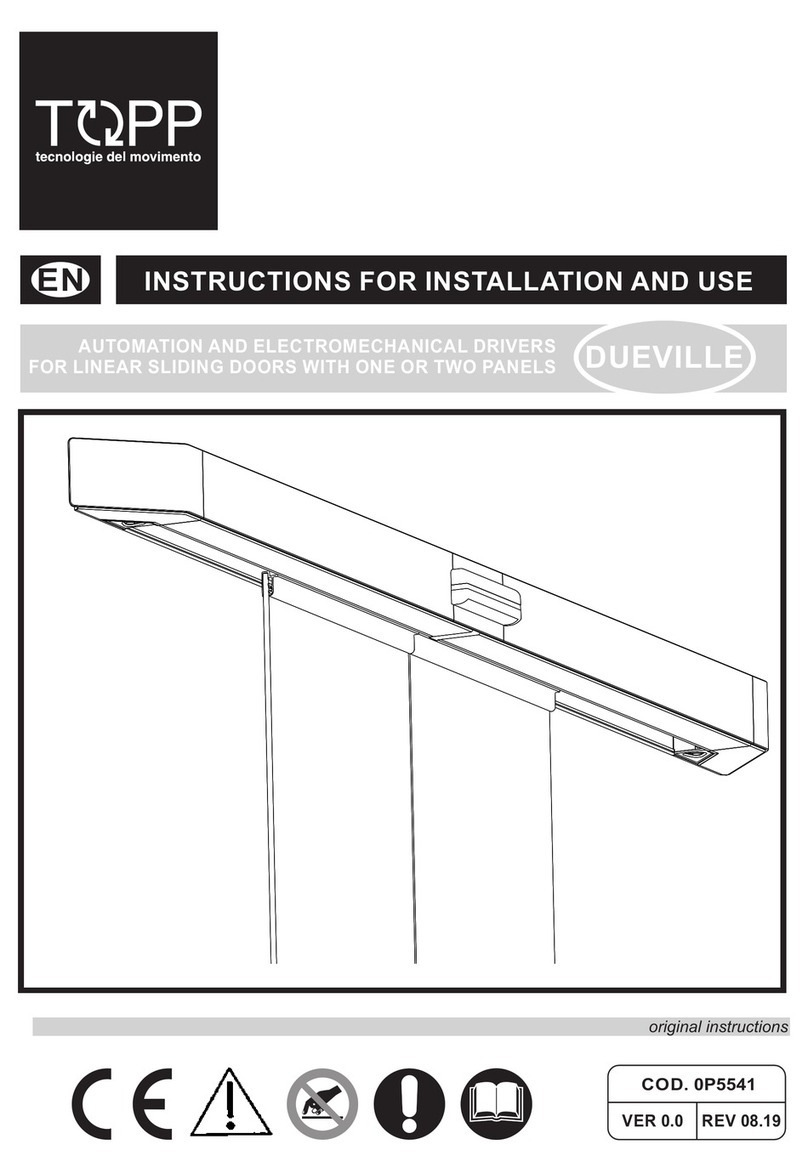
TOPP
TOPP DUEVILLE Instructions for installation and use
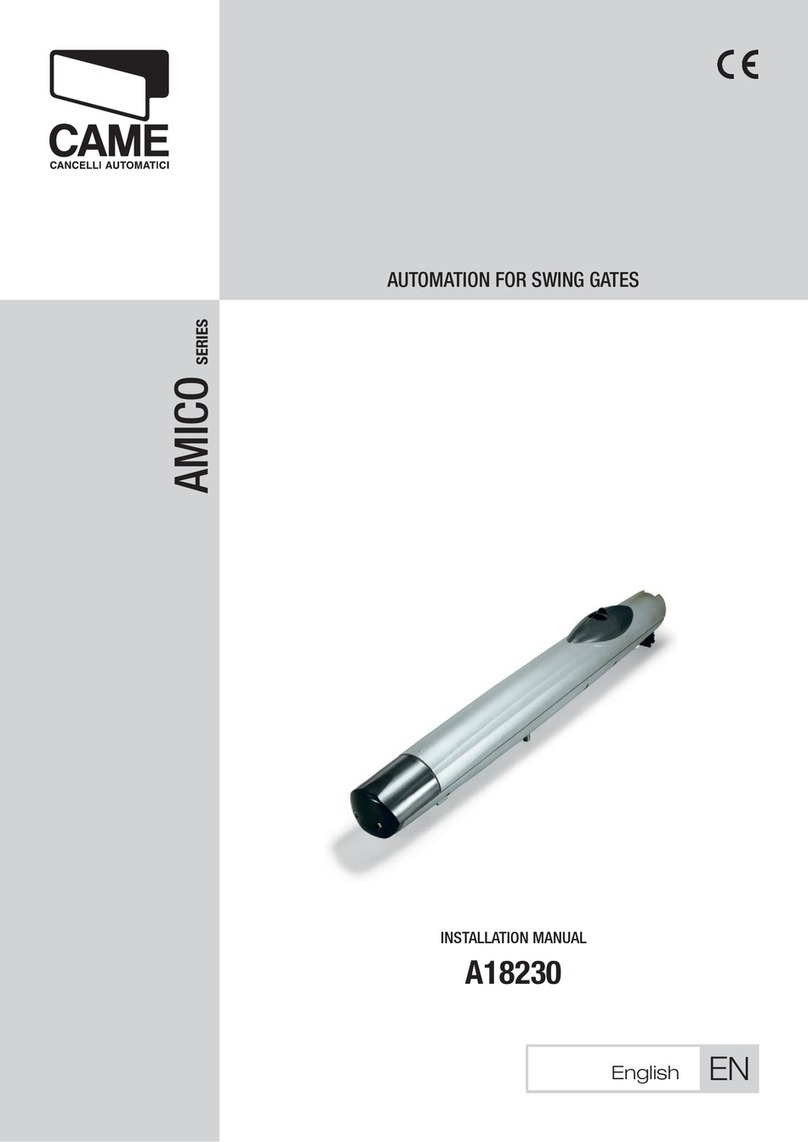
CAME
CAME AMICO Series installation manual
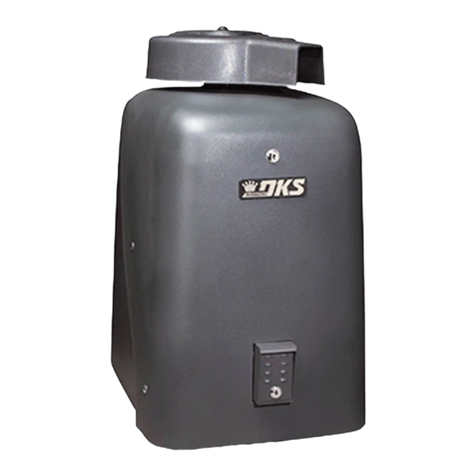
DKS
DKS 6524-081 Installation and owner's guide
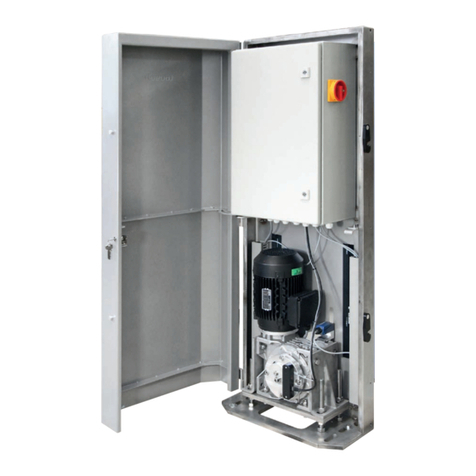
tousek
tousek TPS 60 PRO m6 Mounting and installation manual

Norton
Norton 5700 LEO series Installation and instruction manual
